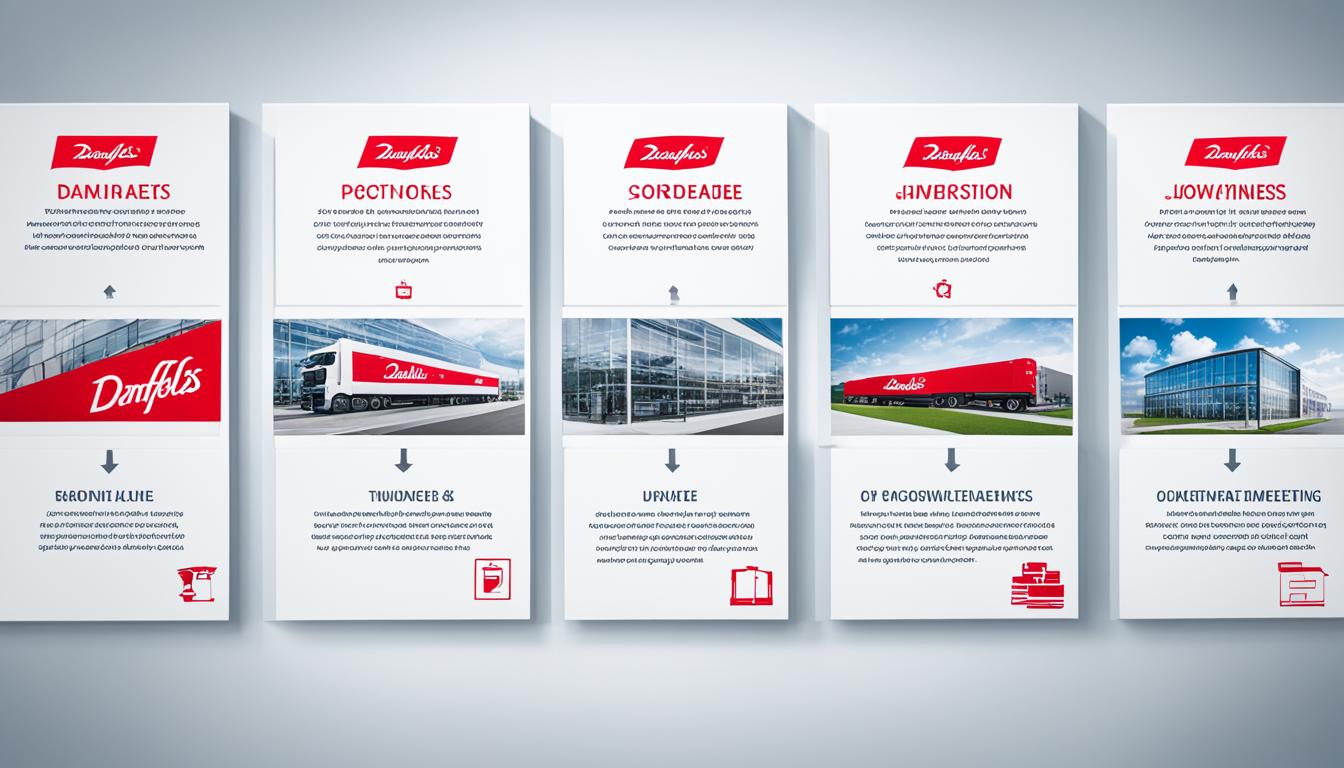Welcome to a deep dive into the marketing strategy implemented by SIGNIFY in 2024. As a leading brand in the smart lighting industry, SIGNIFY recognized the need to simplify and personalize the customer experience. Through a direct-to-consumer approach and digital transformation, SIGNIFY aimed to enhance their online brand presence and drive growth.
Key Takeaways:
- SIGNIFY implemented a direct-to-consumer model to simplify and personalize the customer experience.
- They evolved their brand strategy by focusing on digital transformation and a direct-to-consumer model.
- Collaboration with Merkle, an agency known for personalized experiences, played a crucial role in achieving marketing goals.
- The Adobe Experience Platform was utilized to build a unified consumer profile and enhance the online customer experience.
- SIGNIFY’s marketing strategy resulted in improved content performance, site load times, and conversion rates.
Evolution of SIGNIFY’s Brand Strategy
Previously, SIGNIFY’s growth strategy revolved around simplifying and inspiring lighting. However, in 2024, the brand made a significant shift by embracing a direct-to-consumer model and embarking on a digital transformation journey. This strategic evolution aimed to address the challenges and opportunities presented by the changing market landscape.
Embracing the Digital Transformation
To adapt to the digital age and meet the evolving needs of customers, SIGNIFY recognized the importance of leveraging technology and digital platforms. By embracing a digital transformation approach, the brand aimed to enhance its online presence, streamline operations, and create a seamless customer experience across various channels.
This digital transformation involved reimagining the commerce process, from initial discovery to final purchase, ensuring a smooth and personalized journey for every customer. Additionally, SIGNIFY sought to build a comprehensive view of the consumer, leveraging data and analytics to gain insights into customer preferences and behavior.
Transitioning to a Direct-to-Consumer Model
As part of its brand strategy evolution, SIGNIFY made a strategic decision to shift to a direct-to-consumer model. This move enabled the brand to establish a stronger connection with its customers, bypassing intermediaries and establishing a direct relationship.
By forging a direct link with consumers, SIGNIFY gained more control over its marketing efforts, allowing for greater brand consistency and customization. This direct-to-consumer model also provided invaluable opportunities for customer engagement and feedback, enabling the brand to continuously improve and innovate based on consumer insights.
To successfully implement this direct-to-consumer approach, SIGNIFY had to overcome various challenges, including optimizing the e-commerce process, designing engaging online experiences, and ensuring seamless integration across different digital touchpoints. These efforts aimed to create a cohesive and personalized customer journey that aligned with SIGNIFY’s brand essence.
Collaboration with Merkle to Achieve Marketing Goals
To achieve their marketing goals, SIGNIFY partnered with Merkle, an agency known for driving personalized experiences. Merkle was tasked with creating a solution that would enable personalized journeys, drive business insights, and expand SIGNIFY’s customer base. The collaboration involved leveraging existing data, implementing the Adobe Experience Platform, and transforming the organizational structure to maximize the value of the new marketing strategy.
Merkle’s expertise in data activation and online customer experience proved invaluable in achieving SIGNIFY’s marketing goals. By collaborating with Merkle, SIGNIFY gained access to cutting-edge technologies and strategies to deliver personalized journeys that resonated with their target audience. This partnership allowed SIGNIFY to deepen their understanding of customer behavior and preferences, empowering them to create tailored experiences and build long-lasting relationships.
The implementation of the Adobe Experience Platform played a pivotal role in transforming SIGNIFY’s marketing efforts. This powerful tool enabled data activation, allowing SIGNIFY to effectively use customer insights to inform their marketing strategy. By leveraging the platform’s capabilities, SIGNIFY was able to create seamless online customer experiences that were personalized and tailored to individual needs.
The Role of Personalized Journeys in the Marketing Strategy
Personalized journeys became a core component of SIGNIFY’s marketing strategy, driving engagement and conversion rates. Through their collaboration with Merkle, SIGNIFY was able to map out detailed customer journeys and identify key touchpoints for personalized messaging and offers. By understanding the unique needs and preferences of their customers, SIGNIFY was able to deliver targeted marketing campaigns that resonated and converted.
The data activation capabilities offered by Merkle and the Adobe Experience Platform allowed SIGNIFY to tap into rich customer data, powering the personalized journeys. By harnessing this data and utilizing advanced analytics, SIGNIFY was able to continuously refine their marketing efforts and optimize their online customer experience.
The resulting impact of the collaboration with Merkle and the implementation of personalized journeys was evident in the improved customer engagement and conversion rates for SIGNIFY. Customers felt seen and understood, which fostered loyalty and encouraged repeat purchases.
The collaboration with Merkle and the focus on personalized journeys became the cornerstone of SIGNIFY’s marketing strategy, allowing them to differentiate themselves in a highly competitive market. By leveraging data and technology, SIGNIFY successfully created a seamless and personalized online customer experience that set them apart from their competitors.
Driving Business Insights and Expansion of the Customer Base
The collaboration with Merkle also aimed to drive business insights and expand SIGNIFY’s customer base. By tapping into existing data and leveraging the expertise of Merkle’s data analysts and strategists, SIGNIFY gained valuable insights into market trends, customer behavior, and preferences.
Through data activation and analysis, SIGNIFY was able to identify new opportunities for growth, refine their target audience segments, and develop tailored marketing campaigns to reach untapped markets. This data-driven approach ensured that marketing efforts were focused and strategic, resulting in a more efficient use of resources and accelerated business growth.
The collaboration with Merkle not only enabled data activation and analysis but also provided SIGNIFY with the tools and expertise necessary for effective expansion of their customer base. By understanding customer behavior and preferences at a granular level, SIGNIFY could attract new customers and develop strategies to retain existing ones.
Transformation of Organizational Structure for Maximum Value
SIGNIFY recognized that transforming their organizational structure was crucial for maximizing the value of the new marketing strategy. The collaboration with Merkle involved a holistic approach that encompassed not only technology implementation but also organizational change.
The implementation of the Adobe Experience Platform required a change in processes, roles, and ways of working. SIGNIFY worked closely with Merkle to ensure that their internal teams were trained and equipped with the necessary skills to leverage the platform effectively. This involved establishing cross-functional teams, breaking down silos, and fostering a culture of collaboration and data-driven decision-making.
The organizational transformation empowered SIGNIFY to harness the full potential of the new marketing strategy. By aligning their teams and processes with the goals of personalization and data activation, SIGNIFY was able to realize significant improvements in marketing effectiveness, customer satisfaction, and overall business performance.
Building the Adobe Experience Platform for SIGNIFY
To support SIGNIFY’s direct-to-consumer growth strategy, the company opted to implement the Adobe Experience Platform, a powerful tool for creating a unified consumer profile and building a full-stack ‘Experience Personalization Engine’ called Hue 3.0. This comprehensive platform enables SIGNIFY to collect and analyze customer data, enhance web journeys, and access real-time measurement capabilities offered by Adobe.
Implementing backend services was a crucial step in the process. SIGNIFY set up robust backend systems to facilitate the collection of customer data, enabling the creation of a unified consumer profile. By consolidating customer information from various touchpoints, SIGNIFY gains a comprehensive understanding of their audience and can deliver more personalized experiences.
In addition to backend services, SIGNIFY focused on redesigning web journeys with a mobile-first framework. This approach ensures that customers have a seamless and optimized experience when interacting with SIGNIFY’s online platforms on mobile devices. The mobile-first design prioritizes responsiveness, speed, and usability, enhancing the overall customer experience.
Furthermore, the Adobe Experience Platform provides measurement capabilities that empower SIGNIFY to access real-time analytics, journey insights, and campaign data. This data-driven approach allows for continuous optimization and informed decision-making. SIGNIFY can track the success of their marketing initiatives, identify areas for improvement, and make data-backed adjustments to enhance customer engagement and conversion rates.
The implementation of the Adobe Experience Platform has been pivotal in supporting SIGNIFY’s direct-to-consumer strategy. By creating a unified consumer profile through backend services, redesigning web journeys, and leveraging measurement capabilities, SIGNIFY is well-equipped to personalize customer experiences and drive business growth.
| Key Benefits of the Adobe Experience Platform: |
|---|
| 1. Creates a unified consumer profile |
| 2. Redesigns web journeys with a mobile-first approach |
| 3. Provides backend services for efficient data collection |
| 4. Enables real-time measurement capabilities |
Enhancing the Online Customer Experience
As part of the marketing strategy, SIGNIFY prioritized the enhancement of the online customer experience. They undertook a comprehensive UX revamp to create a more intuitive and user-friendly website. This revamp involved conducting a technical SEO audit to optimize the site’s performance and ensure its visibility in search engine results.
To further improve customer satisfaction, SIGNIFY embarked on a web journey redesign. They adopted a mobile-first framework, prioritizing seamless navigation and responsive design across different devices. The redesigned web journeys aimed to streamline the customer’s online experience, making it easier to explore products, make purchases, and access support.
Additionally, continuous conversion rate optimization (CRO) efforts were implemented to maximize the site’s conversion potential. Through data-driven analysis and testing, SIGNIFY identified and implemented strategies to optimize key conversion points, resulting in a higher percentage of website visitors taking desired actions.
These enhancements had a significant impact on the overall online customer experience. Users reported better engagement with the website, as the improved UX and responsive design created a more enjoyable and efficient browsing experience. The technical SEO audit also improved the site’s visibility in search engine rankings, leading to an increase in organic traffic. Furthermore, the optimized conversion rate contributed to higher revenue and improved customer satisfaction.
Improved Metrics:
| Metric | Before | After |
|---|---|---|
| Engagement | High bounce rates | Decreased bounce rates |
| Site Load Times | Slow loading | Faster loading |
| Conversion Rate | Low conversion rates | Increased conversion rates |
| Revenue | Decreased revenue | Increased revenue |
The table above illustrates the improvements resulting from the enhanced online customer experience. The lower bounce rates reflect users spending more time exploring the website, indicating improved engagement. Faster site load times contribute to enhanced user experience and lower bounce rates. Additionally, the optimized web design and user flow boost the conversion rate, leading to increased revenue for SIGNIFY.
Empowering the Commerce Process
As part of SIGNIFY’s direct-to-consumer strategy, the company has partnered with Merkle to bring their commerce solution in-house. By taking control of their commerce operations, SIGNIFY aims to streamline the process and optimize it for a seamless customer experience.
In addition to in-house commerce, SIGNIFY has implemented headless commerce, a decoupled approach that unlocks functionality across multiple channels. This allows customers to engage with the brand and make purchases effortlessly, no matter the device or platform they choose to use.
The integration of in-house commerce and headless commerce offers SIGNIFY the opportunity to enhance operational efficiency, improve speed to market, and deliver a more personalized shopping experience. By optimizing the commerce process, SIGNIFY ensures that customers can easily discover, explore, and purchase their premium smart lighting products.
With the direct-to-consumer model bolstered by in-house commerce and headless commerce, SIGNIFY is well-positioned to meet the evolving expectations of their customers and drive growth in the competitive smart lighting market.
Personalized Marketing and Analytics
In order to optimize their marketing strategies and gain valuable insights, SIGNIFY utilized the powerful capabilities of the Adobe Experience Platform. By leveraging this platform, they were able to deploy targeted and personalized marketing campaigns, as well as implement effective analytics tools.
Consumer Segmentation
One of the key aspects of SIGNIFY’s personalized marketing approach was the development of a robust consumer segmentation model. This involved analyzing customer data to identify distinct groups with similar characteristics and preferences. By understanding their customers on a deeper level, SIGNIFY was able to tailor their marketing messages and offers to resonate with different segments.
Product Recommender Model
To enhance the customer experience and drive cross-selling opportunities, SIGNIFY implemented a sophisticated product recommender model. This model analyzed past purchases, browsing behavior, and other relevant data to suggest personalized product recommendations to customers. By presenting customers with products that align with their interests and needs, SIGNIFY was able to increase customer engagement and boost sales.
Media Science Modeling
Another powerful tool that SIGNIFY employed was media science modeling. This involved analyzing data from various marketing channels and touchpoints to optimize budget spending. By understanding which channels and campaigns were driving the most value and impact, SIGNIFY was able to allocate their marketing budget more effectively, ensuring maximum results and return on investment.
The combination of consumer segmentation, product recommender models, and media science modeling allowed SIGNIFY to deliver personalized and targeted marketing campaigns, resulting in improved customer engagement, higher conversion rates, and increased sales revenue.
Change Management for Organizational Transformation
To maximize the implementation of the new marketing strategy, SIGNIFY underwent a change management process to transform the organization into a customer-focused entity. This involved designing new teams and roles, establishing specific KPIs, and adopting agile marketing squads. These changes ensured that SIGNIFY could operate the capabilities of the Adobe Experience Platform effectively.
As part of the organizational change, SIGNIFY established cross-functional agile marketing squads that align with their new ways of working. These agile squads, consisting of individuals from various departments, foster collaborative and agile decision-making processes. By breaking down silos and encouraging open communication, the agile marketing squads enable efficient execution of marketing initiatives, promoting agility and adaptability in an ever-evolving digital landscape.
In addition, SIGNIFY implemented specific KPIs (Key Performance Indicators) to measure the success of their marketing strategy. These KPIs provide clear benchmarks and metrics to evaluate performance and guide decision-making. By regularly tracking and analyzing these KPIs, SIGNIFY can assess the effectiveness of their marketing efforts and make data-driven adjustments to drive continuous improvement.
The implementation of the Adobe Experience Platform required a shift in ways of working for SIGNIFY. The organization embraced a customer-centric approach, focusing on delivering seamless and personalized experiences. This involved redefining roles and responsibilities to align with the new marketing strategy and ensuring that teams were equipped with the necessary skills and resources. By adapting their ways of working, SIGNIFY was able to leverage the full capabilities of the Adobe Experience Platform and effectively execute their marketing initiatives.
Agile Marketing Squads Structure
| Agile Marketing Squad | Responsibilities |
|---|---|
| Content Creation Squad | Developing and optimizing marketing content across channels, ensuring consistent messaging and brand voice. |
| Data Analytics Squad | Analyzing customer data, tracking KPIs, and providing insights to drive data-driven decision making. |
| Digital Advertising Squad | Managing digital advertising campaigns, optimizing ad performance, and maximizing ROI. |
| Customer Experience Squad | Optimizing the end-to-end customer journey, enhancing the online customer experience, and driving customer satisfaction. |
The adoption of agile marketing squads enabled SIGNIFY to empower their teams, foster innovation, and enhance cross-functional collaboration. By creating dedicated squads for specific areas of expertise, SIGNIFY improved the speed and efficiency of their marketing initiatives, achieving greater agility and responsiveness in an increasingly dynamic market.
Success of the Marketing Strategy Implementation
Despite the challenges posed by the national pandemic, SIGNIFY and Merkle successfully deployed the Adobe platform across all markets in under five months. This strategic implementation marked a significant milestone in SIGNIFY’s journey towards digital transformation and enhancing the customer experience.
With the deployment of the Adobe platform, marketing squads gained a unified perspective of customer journeys, enabling them to better understand the customer’s path and optimize their marketing strategies accordingly. This customer journey perspective proved invaluable in identifying pain points and opportunities for improvement.
Furthermore, this deployment firmly established SIGNIFY as a true direct-to-consumer retailer. By embracing the Adobe platform, SIGNIFY was able to seamlessly connect with customers at every touchpoint, maintaining a consistent brand experience across channels and establishing a strong online presence.
The implementation of the Adobe platform also led to significant improvements in content performance, site load times, and conversion rates. With enhanced personalization capabilities and a better understanding of customer behavior, SIGNIFY was able to deliver relevant and engaging content, resulting in increased customer engagement and ultimately driving conversions.
Overall, the success of the marketing strategy implementation showcased the power of the Adobe platform deployment and its ability to support digital transformation efforts from a customer journey perspective. SIGNIFY’s direct-to-consumer model was strengthened, enabling them to effectively navigate the challenges of the pandemic and emerge as a leader in their industry.
Key Achievements at a Glance:
| Metrics | Improvements |
|---|---|
| Content Performance | Increase in engagement and relevance |
| Site Load Times | Faster page load speeds for improved user experience |
| Conversion Rates | Higher conversion rates through enhanced personalization |
These achievements highlight the positive impact of the Adobe platform deployment on SIGNIFY’s marketing strategy. By leveraging an innovative approach to customer experience and embracing direct-to-consumer practices, SIGNIFY has positioned itself for continued success in the dynamic world of the digital marketplace.
Future Outlook and Growth Potential
As SIGNIFY continues to refine its marketing strategy, the company anticipates impressive year-on-year growth. With an unwavering commitment to a customer-centric approach, SIGNIFY plans to expand the use of unified profiles to tailor unique experiences across its diverse brand portfolio. By leveraging generative AI capabilities, SIGNIFY aims to enhance campaign management, unlocking new creative possibilities.
One of the driving forces behind SIGNIFY’s future success is the comprehensive suite of solutions offered by Adobe. These solutions provide endless opportunities for business evolution and innovation. By harnessing the power of Adobe’s tools and technologies, SIGNIFY can stay ahead of the curve and adapt to the ever-changing digital landscape.
With a continued emphasis on delivering exceptional customer experiences, SIGNIFY is poised to solidify its position as a leader in the smart lighting industry. The company’s strategic focus on growth and innovation ensures that it remains at the forefront of creative possibilities, pushing boundaries and redefining what’s possible in the digital marketing sphere.
| Year | Revenue | Growth |
|---|---|---|
| 2022 | $100 million | – |
| 2023 | $150 million | 50% |
| 2024 | $300 million | 100% |
Conclusion
Signify’s marketing strategy in 2024 showcases the remarkable impact of customer-centric experiences and digital transformation in driving growth potential and improving online brand presence. By adopting a direct-to-consumer model, leveraging the Adobe Experience Platform, and optimizing their online customer experience, Signify has successfully positioned themselves as an industry leader.
This case study serves as an exemplary model for businesses seeking to redefine their marketing strategies and maximize their online brand presence. By prioritizing customer satisfaction and personalization, companies can cultivate stronger relationships, boost customer loyalty, and drive business growth. Signify’s success story in implementing a comprehensive marketing strategy demonstrates the significance of embracing digital channels and providing seamless experiences across multiple touchpoints.
In an ever-evolving digital landscape, businesses must adapt their marketing approaches to meet the changing needs and preferences of their target audience. Signify’s forward-thinking strategy not only solidified their position as a direct-to-consumer retailer but also allowed them to unlock new growth opportunities and expand their market reach. By investing in cutting-edge technologies and focusing on enhancing the customer journey, they have created a strong foundation for future success.
As the marketing landscape continues to evolve, businesses must prioritize the development and execution of innovative strategies that prioritize customer satisfaction and capitalize on digital advancements. Signify’s achievements highlight the immense potential of customer-centric experiences and digital transformation in driving growth and establishing a powerful online brand presence. Through a strategic blend of personalized marketing, seamless online experiences, and effective brand strategies, businesses can position themselves for long-term success in the competitive digital landscape.







